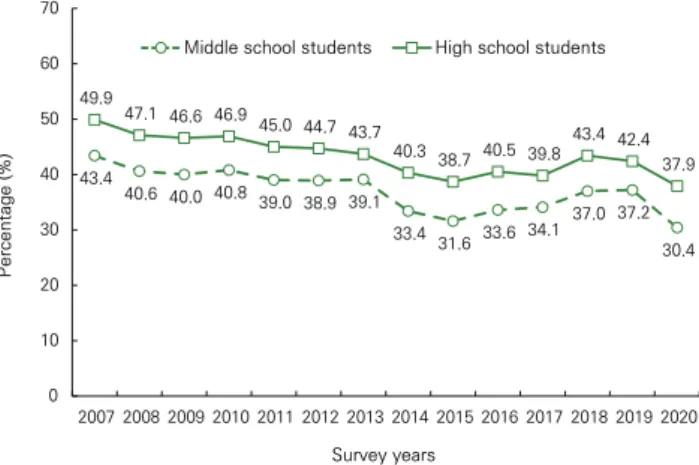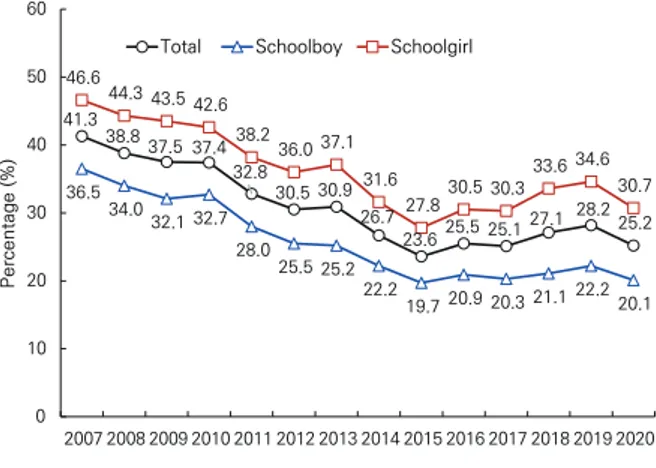주간 건강과 질병•제14권 제15호(2021. 4. 8.)
www.kdca.go.kr
881
만성질환 통계
1. 청소년의 스트레스 인지율 추이, 2007∼2020
◈ 우리나라 청소년의 스트레스 인지율은 2007년 46.5%에서 2020년 34.2%로 12.3%p 감소하였음. 2020년 기준 남학생 28.1%, 여학생
40.7%로 여학생이 남학생보다 스트레스를 더 많이 느끼는 것으로 나타났음(그림 1). 또한 중학생(30.4%) 보다 고등학생(37.9%)이 더 높은
스트레스 인지율을 보였음(그림 2).
46.5 43.7 43.2 43.8 42.0 41.9 41.4 37.0 35.4 37.4 37.2 40.4 39.9 34.2 40.9 38.1 37.3 37.7 35.8 34.8 34.3 30.8 29.6 30.5 30.4 32.0 31.7 28.1 52.8 50.1 50.0 50.7 49.0 49.6 49.3 43.7 41.7 44.9 44.6 49.5 48.8 40.7 0 10 20 30 40 50 60 70 2007 2008 2009 2010 2011 2012 2013 2014 2015 2016 2017 2018 2019 2020 인 지 율 (% ) 조사년도 전체 남학생 여학생그림 1. 남녀학생별 스트레스 인지율 추이, 2007∼2020
43.4 40.6 40.0 40.8 39.0 38.9 39.1 33.4 31.6 33.6 34.1 37.0 37.2 30.4 49.9 47.1 46.6 46.9 45.0 44.7 43.7 40.3 38.7 40.5 39.8 43.4 42.4 37.9 0 10 20 30 40 50 60 70 2007 2008 2009 2010 2011 2012 2013 2014 2015 2016 2017 2018 2019 2020 인 지 율 (% ) 조사년도 중학교 고등학교그림 2. 학교급별 스트레스 인지율 추이, 2007∼2020
* 스트레스 인지율 : 평상시 스트레스를 ‘대단히 많이’ 또는 ‘많이’ 느끼는 사람의 분율
※ 조사대상 : 중학교, 고등학교 재학생
출처 : 제16차(2020년) 청소년건강행태조사 통계, http://www.kdca.go.kr/yhs/
주간 건강과 질병•제14권 제15호(2021. 4. 8.)
www.kdca.go.kr
882
2. 청소년의 우울감 경험률 추이, 2007∼2020
◈ 우리나라 청소년의 우울감 경험률은 2007년 41.3%에서 2020년 25.2%로 16.1%p 감소하였음. 2020년 기준 남학생 20.1%, 여학생 30.7%로
여학생의 우울감 경험률이 1.5배 더 높았으며(그림 3), 중학생(22.9%)보다 고등학생(27.4%)이 더 높은 우울감 경험률을 보였음(그림 4).
41.3 38.8 37.5 37.4 32.8 30.5 30.9 26.7 23.6 25.5 25.1 27.1 28.2 25.2 36.5 34.0 32.1 32.7 28.0 25.5 25.2 22.2 19.7 20.9 20.3 21.1 22.2 20.1 46.6 44.3 43.5 42.6 38.2 36.0 37.1 31.6 27.8 30.5 30.3 33.6 34.6 30.7 0 10 20 30 40 50 60 2007 2008 2009 2010 2011 2012 2013 2014 2015 2016 2017 2018 2019 2020 경 험 률 (% ) 조사년도 전체 남학생 여학생그림 3. 남녀학생별 우울감 경험률 추이, 2007∼2020
38.3 35.2 34.5 34.4 30.0 28.2 29.0 24.4 21.2 22.7 23.5 25.2 26.9 22.9 44.6 42.7 40.6 40.3 35.5 32.6 32.6 28.8 25.6 27.7 26.4 28.7 29.4 27.4 0 10 20 30 40 50 60 2007 2008 2009 2010 2011 2012 2013 2014 2015 2016 2017 2018 2019 2020 경 험 률 (% ) 조사년도 중학교 고등학교그림 4. 학교급별 우울감 경험률 추이, 2007∼2020
* 우울감 경험률 : 최근 12개월 동안 2주 내내 일상생활을 중단할 정도로 슬프거나 절망감을 느낀 적이 있는 사람의 분율
※ 조사대상 : 중학교, 고등학교 재학생
출처 : 제16차(2020년) 청소년건강행태조사 통계, http://www.kdca.go.kr/yhs/
작성부서 : 질병관리청 만성질환관리국 만성질환관리과
주간 건강과 질병•제14권 제15호(2021. 4. 8.)
www.kdca.go.kr
883
Noncommunicable Disease (NCD) Statistics
1. Trends in prevalence of psychological stress among Korean adolescents,
2007-2020
◈ Prevalence of psychological stress among adolescents in Korea decreased by 12.3%p, from 46.5% in 2007 to 34.2% in 2020. The
data in 2020 indicated that girls feel more stress than boys, with the proportion in boys being 28.1%, and girls 40.7% (Figure 1). The
proportion was also higher in high school students (37.9%) than middle school students (30.4%) (Figure 2).
46.5 43.7 43.2 43.8 42.0 41.9 41.4 37.0 35.4 37.4 37.2 40.4 39.9 34.2 40.9 38.1 37.3 37.7 35.8 34.8 34.3 30.8 29.6 30.5 30.4 32.0 31.7 28.1 52.8 50.1 50.0 50.7 49.0 49.6 49.3 43.7 41.7 44.9 44.6 49.5 48.8 40.7 0 10 20 30 40 50 60 70 2007 2008 2009 2010 2011 2012 2013 2014 2015 2016 2017 2018 2019 2020 Pe rc en ta ge (% ) Survey years Total Schoolboy Schoolgirl
Figure 1. Trends in Prevalence of psychological stress in
male and female students, 2007-2020
43.4 40.6 40.0 40.8 39.0 38.9 39.1 33.4 31.6 33.6 34.1 37.0 37.2 30.4 49.9 47.1 46.6 46.9 45.0 44.7 43.7 40.3 38.7 40.5 39.8 43.4 42.4 37.9 0 10 20 30 40 50 60 70 2007 2008 2009 2010 2011 2012 2013 2014 2015 2016 2017 2018 2019 2020 Pe rc en ta ge (% ) Survey years
Middle school students High school students
Figure 2. Trends in Prevalence of psychological stress by
school levels, 2007-2020
* Prevalence of psychological stress: proportion of those who feel “much” or “very much” stressed psychologically in everyday life
※ Surveyed population: middle school and high school students in Korea
Source: The Korea Youth Risk Behavior Survey (KYRBS), http://www.kdca.go.kr/yhs/
*The Korea Youth Risk Behavior Survey is a national school-based survey to assess the prevalence of and monitor trends in health-risk
behaviors among Korean adolescents.
주간 건강과 질병•제14권 제15호(2021. 4. 8.)
www.kdca.go.kr
884
2. Trends in proportion of Korean adolescents who experienced depression,
2007-2020
◈ The proportion of adolescents who experienced depression decreased by 16.1%p, from 41.3% in 2007 to 25.2% in 2020. According
to 2020 data, the proportion was 1.5 fold higher in girls (30.7%) than boys (20.1%) and high school students (27.4%) displayed higher
proportion than middle school students (22.9%) (Figure 3, 4)
41.3 38.8 37.5 37.4 32.8 30.5 30.9 26.7 23.6 25.5 25.1 27.1 28.2 25.2 36.5 34.0 32.1 32.7 28.0 25.5 25.2 22.2 19.7 20.9 20.3 21.1 22.2 20.1 46.6 44.3 43.5 42.6 38.2 36.0 37.1 31.6 27.8 30.5 30.3 33.6 34.6 30.7 0 10 20 30 40 50 60 2007 2008 2009 2010 2011 2012 2013 2014 2015 2016 2017 2018 2019 2020 Pe rc en ta ge (% ) Survey years Total Schoolboy Schoolgirl
Figure 3. Trends in depression experience of male and
female students, 2007-2020
38.3 35.2 34.5 34.4 30.0 28.2 29.0 24.4 21.2 22.7 23.5 25.2 26.9 22.9 44.6 42.7 40.6 40.3 35.5 32.6 32.6 28.8 25.6 27.7 26.4 28.7 29.4 27.4 0 10 20 30 40 50 60 2007 2008 2009 2010 2011 2012 2013 2014 2015 2016 2017 2018 2019 2020 Pe rc en ta ge (% ) Survey yearsMiddle school students High school students

